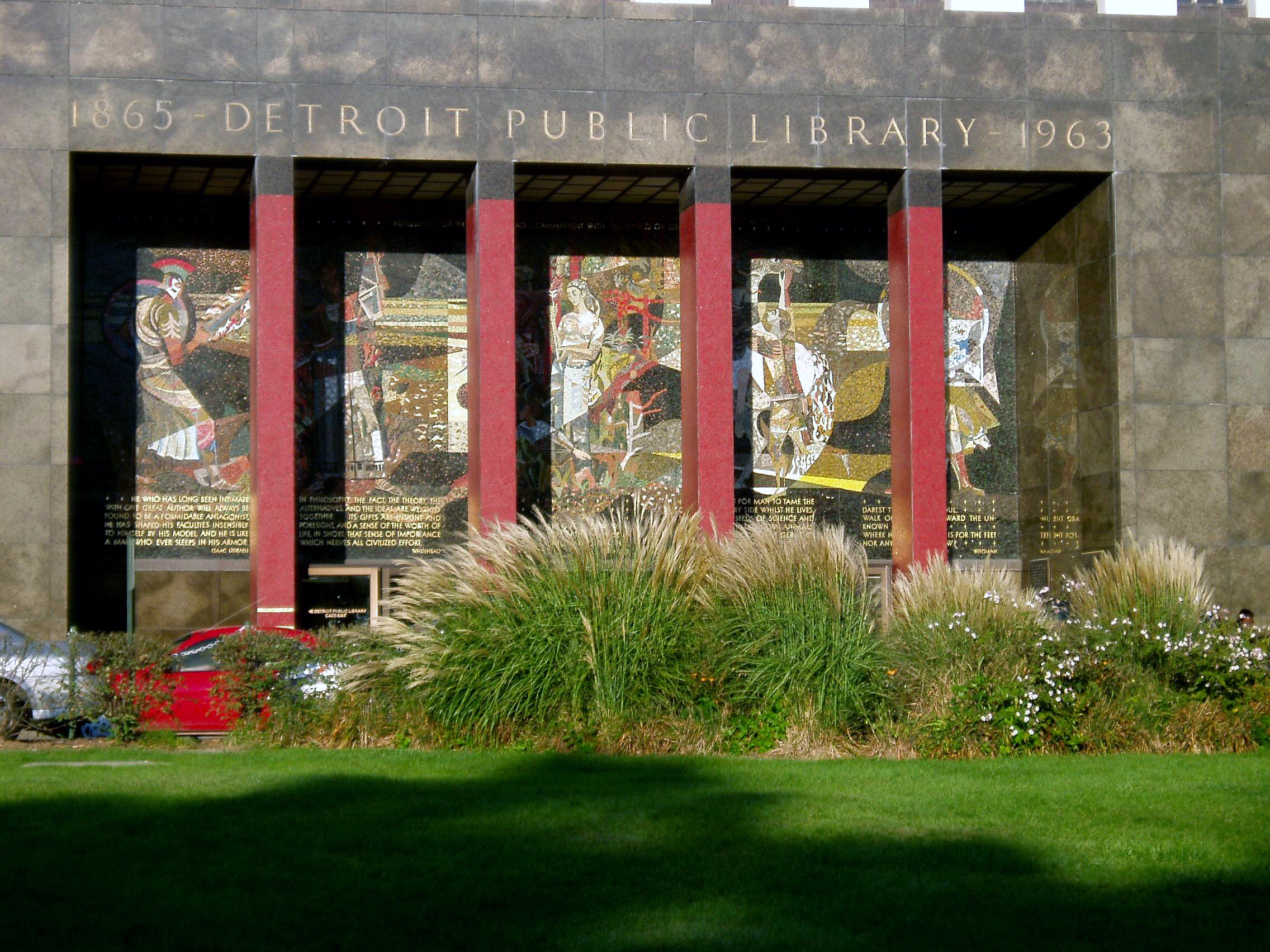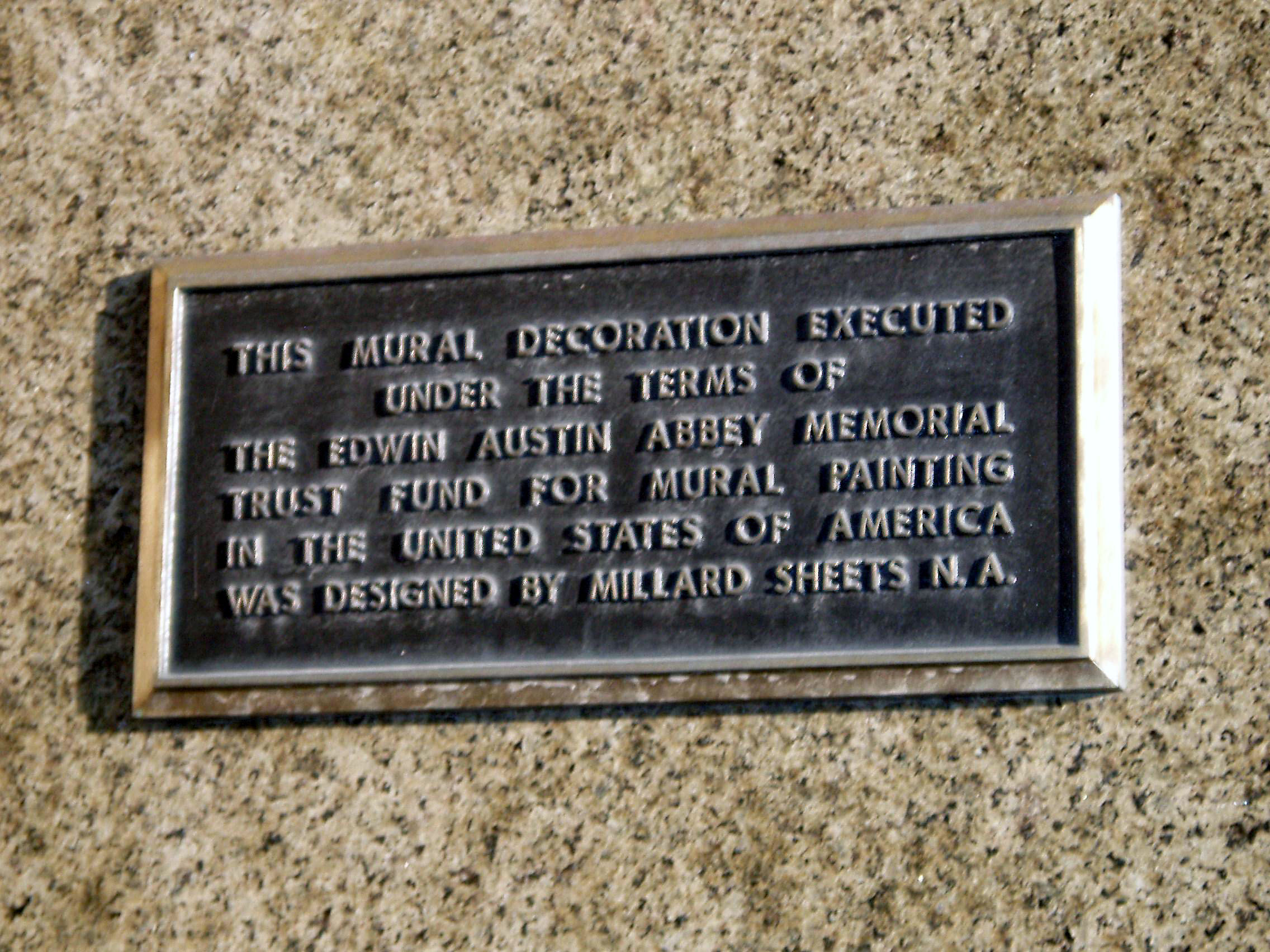

Early in the 1960s, an attractive Cass Avenue entrance was
added to the marvelous Detroit Public
Library building that Cass Gilbert
designed in the early 1920s. At this time two wings were added to the building.
This Cass Avenue entrance features white marble facades, red columns and dark green marble.
The highlight, however, is the large mosaic that Millard Sheets designed for
the library. It is the most impressive public mosaic in th e metropolitan area.
It is a large one: 16 feet by 42 feet and extremely colorful. The best time to appreciate
Sheets’ sparkling work is when the late afternoon sun glistens upon it.
It presents the image of a river of knowledge that both sustains us and connects
us to the past. To benefit from that river of knowledge, Detroit residents
can learn from the resources in Library that contains that knowledge.
e metropolitan area.
It is a large one: 16 feet by 42 feet and extremely colorful. The best time to appreciate
Sheets’ sparkling work is when the late afternoon sun glistens upon it.
It presents the image of a river of knowledge that both sustains us and connects
us to the past. To benefit from that river of knowledge, Detroit residents
can learn from the resources in Library that contains that knowledge.
Merrill Sheets was born in Pomona, California in 1907. His mother died when
he was a baby, so his father sent him to be raised by his maternal grandparents.
They recognized his artistic talents while he was very young and introduced
him to an accomplished Polish artist, Theodore B. Modra, who had retired to
Pomona. Sheets got his early artistic training from that artist. He studied
at the Chouinard Art Institute in Los Angeles and, even as a teenager, won
accolades for his watercolors. By his early twenties, his works had been displayed
in many of the larger cities of this country and in Paris. In 1929, he won
an art competition in San Antonio with a cash prize. He used the money to travel
to Paris where he studied with Albert Dorfinant, an accomplished print maker
and poster designer whose colorful works are still collected. During the mid-1930s,
Sheets completed his undergraduate work in art at Scripps College in Claremont,
California and then, upon graduation, that institution asked him to head a
new program in the fine arts. Scripps College had been founded in 1926 as a progressive institution by Ellen Browning Scripps, the sister of James Scripps who founded the Detroit News. The funds Ellen Scripps used were, I believe, from the newspaper empire that she and her brother owned.
During World
War II, he served as a wartime journalist
and artist for Life magazine in India and Burma. In 1953, he established the
Millard Sheets Design Company in Los Angeles. This developed into a large firm
employing numerous artists, architects and designers. At about this time, Millard
Sheets and his collaborators became well known for the colorful large murals
they designed for public buildings. The River of Knowledge Mosaic is one of
his earlier works of this type. Sheets created The Family of Man mural for
the Los Angeles City Hall, murals for the Mayo Clinic in Rochester, Minnesota,
the “Touchdown Jesus” mural for the library of the University of
Notre Dame and the colorful dome of the Shrine of the Immaculate Conception
in Washington.
This mural was installed at the modern Cass Avenue entrance of the Detroit
Public Library thanks to contributions from the Edwin Austin Abbey Memorial
Trust Fund. Edwin Abbey was born in Philadelphia in 1852 and educated at the
Philadelphia Academy of Art, but spent most of his professional life as an
illustrator, artist and muralist in England. He painted a major mural for the
Boston Public
Library in the 1890s and created the art works and mural for the rotunda of
Pennsylvania’s capitol in Harrisburg. After his death, his widow, Gertrude,
established a memorial trust fund in his memory in 1911. Originally, the trust
supported housing for art students who were learning their profession in London.
In 1926, she donated additional monies and the Abbey Trust Fund began to not
only support art students, but also assist in the installation of murals. It
is pleasant to think that the creative work of one artist—Edwin Austin
Abbey—enabled the Detroit Public Library to recruit the nation’s
most accomplished muralist in about 1960 to install The River of Knowledge
mosaic.
Artist: Millard Sheets
Date of Installation: 1963
City of Detroit Local Historic District: The Cultural Center is not a City
of Detroit Local Historic District.
State of Michigan Registry of Historic Sites: The Detroit Public Library is
included within the Cultural Center Historic District designated as Michigan
Historic Site #P25056 on November 21, 1983.
National Register of Historic Places: The Detroit Public Library is included
within the Cultural Center Historic District that was listed on the National
Register of Historic Places on November 21, 1983.
Use in 2014: Public Art
Book about the Muralist: Millard Sheets: One Man Renaissance by Annie Lovoos
Edmund and Edmund F. Penney (Northland Publishing, 1984)
Photograph: Ren Farley; September, 2005
Description updated: February, 2014
Return to Public Art and Sculpture